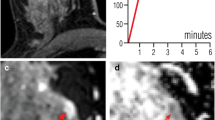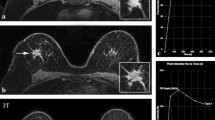Abstract
Background
This study aimed to investigate (1) the MRI and clinical findings useful to differentiate malignant from benign spiculated masses and (2) the diagnostic criteria of spiculated masses for BI-RADS MRI category 5, for which any non-malignant biopsy result is considered discordant and a re-biopsy is recommended.
Materials and methods
Spiculated breast masses, depicted by 3.0/1.5-T contrast-enhanced MRI between June 2008 and March 2014, were retrospectively analyzed. Patient’s age, lesion size, minimum/average apparent diffusion coefficient values (ADCmin/ADCave), and BI-RADS descriptors were compared between malignant and benign lesions. Based on these results, we assessed criteria to define category 5 spiculated masses with a ≥95 % probability of malignancy and evaluated their diagnostic performance.
Results
A total of 140 lesions (Malignant group, n = 131; Benign group, n = 9) were analyzed. Patient’s age, lesion size, ADCmin and ADCave showed significant differences between the two groups, while none of the BI-RADS descriptors, including kinetic curve assessment, showed any significant difference in frequency. Multivariate logistic regression analysis demonstrated that patient’s age and lesion size were the significant predictive factors of malignancy. Of all the assessed criteria for category 5 spiculated masses, “age >50 years or size >9 mm, or both” were selected as the best criteria to minimize the possibility of unnecessary re-biopsies and inappropriate follow-up for malignancies.
Conclusions
Patient’s age and lesion size are useful to differentiate malignant from benign spiculated breast masses. In cases with non-malignant biopsy results, spiculated masses with “age >50 years or size >9 mm, or both” are more likely malignant.




Similar content being viewed by others
References
Franquet T, De Miguel C, Cozcolluela R, Donoso L. Spiculated lesions of the breast: mammographic-pathologic correlation. Radiographics. 1993;13:841–52.
Liberman L, Abramson AF, Squires FB, Glassman JR, Morris EA, Dershaw DD. The breast imaging reporting and data system: positive predictive value of mammographic features and final assessment categories. AJR Am J Roentgenol. 1998;171:35–40.
Nunes LW, Schnall MD, Orel SG. Update of breast MR imaging architectural interpretation model. Radiology. 2001;219:484–94.
Andersson I, Ikeda DM, Zackrisson S, et al. Breast tomosynthesis and digital mammography: a comparison of breast cancer visibility and BIRADS classification in a population of cancers with subtle mammographic findings. Eur Radiol. 2008;18:2817–25.
Kuhl C. The current status of breast MR imaging. Part I. Choice of technique, image interpretation, diagnostic accuracy, and transfer to clinical practice. Radiology. 2007;244:356–78.
Morris EA, Comstock CE, Lee CH, et al. ACR BI-RADS® Magnetic Resonance Imaging. In: ACR BI-RADS® Atlas, Breast Imaging Reporting and Data System. Reston, VA: American College of Radiology, 2013.
Ung OA, Lee WB, Greenberg ML, Bilous M. Complex sclerosing lesion: the lesion is complex, the management is straightforward. ANZ J Surg. 2001;71:35–40.
Shaheen R, Schimmelpenninck CA, Stoddart L, Raymond H, Slanetz PJ. Spectrum of diseases presenting as architectural distortion on mammography: multimodality radiologic imaging with pathologic correlation. Semin Ultrasound CT MR. 2011;32:351–62.
Uematsu T, Kasami M, Yuen S, Igarashi T, Nasu H. Comparison of 3- and 1.5-T dynamic breast MRI for visualization of spiculated masses previously identified using mammography. AJR Am J Roentgenol. 2012;198:W611–7.
Lakhani SR, Ellis IO, Schnitt SJ, et al. WHO classification of tumours of the breast. 4th ed. Lyon: IARC; 2012. p. 111–8.
Liberman L, Mason G, Morris EA, Dershaw DD. Does size matter? positive predictive value of MRI-detected breast lesions as a function of lesion size. AJR Am J Roentgenol. 2006;186:426–30.
Yamaguchi K, Schacht D, Sennett CA, et al. Decision making for breast lesions initially detected at contrast-enhanced breast MRI. AJR Am J Roentgenol. 2013;201:1376–85.
Guo Y, Cai Y, Cai Z, et al. Differentiation of clinically benign and malignant breast lesions using diffusion-weighted imaging. J Magn Reson Imaging. 2002;16:172–8.
Hatakenaka M, Soeda H, Yabuuchi H, et al. Apparent diffusion coefficients of breast tumors: clinical application. Magn Reson Med Sci. 2008;7:23–9.
Woodhams R, Matsunaga K, Iwabuchi K, et al. Diffusion-weighted imaging of malignant breast tumors: the usefulness of apparent diffusion coefficient (ADC) value and ADC map for the detection of malignant breast tumors and evaluation of cancer extension. J Comput Assist Tomogr. 2005;29:644–9.
Author information
Authors and Affiliations
Corresponding author
Ethics declarations
Conflict of interest
None of the authors have any financial relationship with any organization related to this study.
About this article
Cite this article
Onishi, N., Kataoka, M., Kanao, S. et al. A pilot study to determine the diagnostic criteria of spiculated masses for BI-RADS MRI category 5: when to perform re-biopsy after discordant pathologic result?. Breast Cancer 24, 69–78 (2017). https://doi.org/10.1007/s12282-016-0668-5
Received:
Accepted:
Published:
Issue Date:
DOI: https://doi.org/10.1007/s12282-016-0668-5




